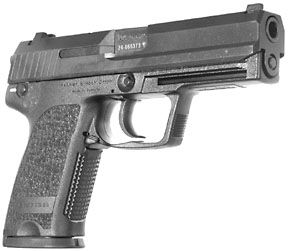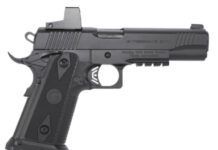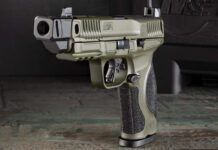
It seems like only yesterday that high-capacity 9mm pistols (owing to their European influences) were being referred to as wunderkind and the 1911-style pistol was being shoved aside. But new machining techniques have brought the Browning design back to prominence, even as “hybrid” Traditional Double Action (TDA) pistols and the polymer striker-fired pistols continue to evolve.
At the source of the polymer guns’ development is the desire to make the guns easier to fire but still offer additional safety features. Of course, cocked-and-locked carry of the 1911 already offers this: two mechanical safeties that must be disengaged for the gun to fire with a nice single-action squeeze. Also, another system touted as safer than the 1911 (but totally devoid of mechanical safeties) is the double-action revolver. Only its extra-long pull stands between the finger and detonation. It is certainly possible to get a safe, smooth, shootable double action, but it’s rare to see a quality DA pull in a gun that’s straight out of the box.
In this test we evaluate three 9mm pistols that attempt to add security by offering either the long pull of a DA revolver, the external safeties of a 1911, or, a little bit of both, all on the same frame. Sturm, Ruger, & Company has long offered a TDA 9mm, and a K designation added to the front of the P-series pistol denotes that after the decocker has been depressed (lowering the hammer safely over a loaded chamber), it must be raised manually to reconnect the ignition system with the movement of the trigger.
Heckler & Koch continues to offer its USP series with a lever that serves not only as a decocker but can be used to lock the hammer in the raised position, just like on a 1911-style pistol. Though the USP does not offer the complement of a 1911-type grip safety, Springfield’s new Extreme Duty (XD) offers a grip safety, but not a thumb safety nor decocker. Which combination of features is best? We went to the range to find out.
Range Session
At 25 yards we fired from sandbags fully supporting the underside of the frame and grip. We supported our wrists and forearms as well. All listed accuracy data was the result of firing in the single-action mode. Velocities and related data were fired over an Oehler 35P chronograph. Also, all three pistols were fired standing unsupported for a minimum of 150 rounds with a variety of commonly available 9mm ammunition. This included strings of fire from single action only and double action only. Though the Springfield XD utilizes only one trigger mode, we practiced transitions from DA to SA on the remaining two test guns. This included multiple runs at a plate rack consisting of six 8-inch plate and paper targets, each of which were placed 10 yards downrange. We like the plate rack for testing the ability to track the sights and push the gun from target to target. We like paper targets because they do not lie.
Our ammunition included Black Hills 147-grain subsonics, Federal American Eagle 124-grain FMJs, and a new jacketed ammunition from Federal that expands like a hollowpoint. Here’s how the guns performed.
Springfield Extreme Duty (XD), $489
The XD is imported from Croatia, and everyone wants to know if it is actually a new version of the Intrac HS2000. It would seem so to us, even though on the surface the XD is treated to better graphics and forward cocking serrations and a more generous cut to accommodate the disassembly lever. An accessory rail has also been molded into the dust cover of the XD. The cost of adding these features plus the assumption of quality-control responsibilities has raised the MSRP from $419 for the HS to $489 for the XD. Still a modest price, in our opinion.
We tested the HS2000 in the April 2001 issue and wished for only two improvements. One was a wider grip safety that was easier to compress. The Springfield XD offers this. We also complained of flyers, a problem we thought was related to the frame and slide being mated at the rear only by molded polymer. The XD is no different, but though we complained of unpredictable accuracy from the HS2000, the worst we could say about the Springfield XD was that it tended to print a little high.
The XD, code for Extreme Duty, is an interesting synthesis of two popular systems. For one, the use of polymer and the safety release hinged inside the face of the trigger borrows from Glock pistols. Pressing this safety flush with the trigger unlocks its movement. The XD is striker, rather than hammer, fired. This means the primer is not struck with a hammer and punch-like movement as in the operation of our other two test pistols. Instead, the striker is pre-loaded and released. When the striker is poised and ready to move, it protrudes from the rear of the XD’s slide to warn the shooter. Also, if the chamber is loaded, an indicator pops up from the rear of the barrel hood.
However, this pistol cannot be decocked. The ability to include a usable decocker is still in question on guns of this type. Walther introduced a decocker in its polymer P99 series pistols to aid safer administrative handling. But, this design required a small movement of the slide to reset the striker. Doing so without disturbing the chambered round could prove to be too fine a motor skill to perform in what would likely be a stress-filled combat situation. While foregoing a decocker, Springfield’s XD pistol does include a drop-proof firing-pin block and the aforementioned grip safety. The object, of course, was to ensure that the gun would fire only as the result of a deliberate movement.
The other two pistols also include a hinged trigger, but the XD requires a take-up and press much closer to a single-action 1911 pistol. The take-up is predictable, and the required 8-pound press is consistent. Ergonomics were neutral. No staffers were tempted to readjust their grip between shots. Firing consisted solely of aligning sights, establishing the break point in the trigger and overcoming it.
In terms of accuracy the XD finished just behind the HK USP 9. While all three test ammunitions were different, the results downrange were nearly identical. The subsonic 147-grain full metal-jacketed (FMJ) rounds from Black Hills, the typical 124-grain FMJ cartridge by Federal American Eagle, and the new Federal Premium FMJ all grouped right around 2.5 inches. The best groups measured just over 2 inches and the worst right at 3 inches. We credit this to the gun’s consistent trigger and clear sights and a small feature we do not recall seeing on the HS2000. To aid lockup, the forward 0.4-inch of the barrel is wider to mate with the slide. With this upgrade in hand, any time we picked up the XD the shooter knew just what to expect in terms of grip, take-up and break.
Heckler & Koch USP, $699
If the XD is a hybrid, then so is the USP series from Heckler & Koch. Both the XD and the USP blend features of the nearly 100-year-old 1911 design with the controls of more recent designs. The frame of the USP is also made of polymer, but without the top end in place it is evident that the grip frame is perhaps the lightest and thinnest of all plastic guns. Though the XD releases its magazines with a button on each side of the frame just above the front strap (another 1911 trait), the USP requires a downward push to engage the lever, which blends into the rear lower corner of the trigger guard. This lever is ambidextrous, but it requires the experienced shooter to come up with a fresh plan for releasing the mag. Left-handed shooters forced to use right handed semi-autos have for years used the trigger finger to pop the magazine button. Most of our test staff chose this method, while some simply added a downward sweep to their standard technique, which uses the strong-hand thumb.
Though there is no grip safety on the USP, HK managed to steal a page from John Browning anyway. On the left side of the pistol (this lever can be switched to the other side if desired) at the rear of the slide is a thumb-operated lever that can either decock the hammer, lowering it safely on a loaded chamber or, moved upward to lock the hammer back. This means that the next shot will be triggered single action once this safety is released. The proper use of first shot double action or first shot single action is the source of some confusion. Exactly what was the original design intent?
We checked with Bank Miller of the SigArms Academy. Even though the HK gun is a competing brand, many students pass through this training school with all sorts of weapons. According to Miller, the double-action mode was meant as a safety-on position. Any time there is an opportunity to do so, the student is instructed to go to single-action-only fire by thumbing back the hammer. On today’s semi-autos (and revolvers), blocks are installed so that even if the hammer slips from under the thumb and falls, the firing pin will not contact the round unless the trigger is also depressed. When all is clear, the gun may then be decocked to safe.
The HK system goes one better. The thumb safety allows the pistol to stay in single action, which is the higher state of readiness with assured safety. While not recommended as a continuous practice by the manufacturer, the HK USP may even be holstered hot, with the hammer-back safety on.
The HK pistol is more expensive than the other pistols in this test, but it is not the most expensive variation of this design. Above the USP in the HK lineup is the Expert model, which carries an MSRP of just over $1,000 dollars. Still, the extra $200 or so above the cost of the Ruger or Springfield Armory pistols does buy you a couple of steps up the pyramid toward match grade accuracy, as our testing showed. In fact, we nearly kept all groups fired with the Black Hills ammunition under 2 inches at 25 yards.
One important difference between the USP and Expert series is the way the barrel locks up at the front of the slide. The Expert uses an O-ring system. The USP employs a slightly raised area on the outside of the barrel from the muzzle back, though not as pronounced as in the profile found on the barrel of the Springfield XD, nor is it as effective as the addition of the O-ring. The other components of accuracy are sights and trigger.
The sights on the HK pistol are tops. They avoid snagging clothing but still offer target quality. While both the XD and the Heckler & Koch pistols use three-dot sights dovetailed into place, the rear unit on the HK is given a pyramid shape to speed the shooter’s eye to the notch where the front sight should be found. The dovetails and corresponding units are large and strong looking.
Other features worthy of note are a generous accessory rail molded into the dust cover, effective checkering molded into the front and back straps, and an externally mounted extractor.
Our first impression upon firing the USP had to do with its size. We were practicing leveling the gun at the plate racks from low ready. Our choice of mode was to fire the first shot double action and follow up by firing at the remaining plates single action. On day one it seemed like a long length of pull. By the end of the test we had changed our mind and felt totally comfortable. The change in trigger position inside the trigger guard between DA and SA did not measure out to be much different than on the Ruger KP95, but the feel and resulting control was markedly different. The HK USP presents perhaps the least impression of transition of any TDA pistol we have tried to date. Combining this aspect with the best sights and accuracy among our trio of test guns, we posted our fastest times at the plate rack.
Ruger KP95, $453
The Ruger P-series is a tried-and-true design that gains the K designation by adding a Safe position to the decocking lever. This lever is ambidextrous, but the right side lever is abbreviated. Depending on your hands or preference, operation is available to either thumb when using a two-handed hold.
The grip frame, trigger guard and dust cover are polymer. Few people think of Ruger when they think of a plastic gun, but this design has been around for quite some time. Features continued from the P series to the KP include an externally mounted extractor, double pinned low mount front sight, dovetailed rear sight adjustable for windage with locking screw, full length guide rod and fully supported chamber with ramped barrel. Cocking serrations are rear only, and while the ambidextrous magazine releases ensure against accidentally dropping the mag, we could never make up our mind if we love or hate them, let alone whether to use the thumb or forefinger.
The P series has never been considered a target weapon, but instead one that is reliable, sturdy and affordable. We had our best luck firing the Federal American Eagle 124-grain FMJ round, which averaged out to a five-shot group size of just 2.2 inches. The KP95 is nothing fancy, nor was it ever meant to be. As the field of available ammunition has increased, one theory holds that older design firearms will still perform better with the older cartridges. While the expanding FMJ from Federal gave us no problems whatsoever, we did in fact have some trouble with reliability when firing some of the more aggressively shaped hollowpoints. The roundnosed FMJ continues to be the most reliably feeding slugs in 9mm across the board. No wonder Federal went to the trouble of developing a FMJ that would do the job of a hollowpoint.
If we experienced any other problem with the KP95, we felt that it centered on our familiarity with the trigger and slide velocity. In terms of effective continuous fire, we felt the least sure when in the single action mode. The hinged trigger had the least feedback and we often found the gun going off sooner than we expected. Part of the blame is that each of these three guns is very different in feel. Were the KP95 our only pistol, we are sure familiarity would minimize this problem.
Another characteristic that made it hard to shoot on time was the slide seemed not to move at optimum speed. Sometimes the slide would hesitate and destabilize our hold. This could be traced to matching the proper strength ammunition to the combination of the weight of the slide and the power of the recoil spring. In the case of the supplied recoil spring, we’re afraid one size does not fit all.
Compared to the XD, which will likely sell for not much more than the KP95, we feel there is a big difference in the type of buyer for each pistol. The XD does not offer a safety that is in effect a true “off-button.” It is an inexpensive pistol for the experienced, if not professional, shooter. The KP95 includes a sort of kill switch in its decocking mechanism that deactivates the gun. In today’s market, we see it as a budget gun for self-protection to be purchased by the average citizen who will likely not make shooting a regular activity.
Gun Tests Recommends
Springfield Armory XD, $489. Best Buy. We can’t vouch for this pistol in every caliber, but as a platform for launching 9mm Parabellum we feel it is very close to ideal. The size and grip feel natural, and the trigger is consistent. These are attributes rarely seen in this price range, in our opinion.
Heckler & Koch USP, $699. Buy It. This is a sophisticated pistol with a trigger and safety system that offers more than one effective mode of fire. The sights are both precise and quick, a rare combination. It’s expensive, but in this test, it’s head and shoulders above most polymer pistols.
Ruger KP95, $453. Conditional Buy. We found this pistol to be a solid performer, but with a narrower choice of ammunition. It appears to be limited to cartridges that provide just the right amount of slide velocity for consistent control because it balked at the more radically profiled hollowpoints.



























